How to properly grow and use green chili peppers and to whom they are contraindicated
Spicy lovers appreciate green chilies. Most often it can be found in powder form in sauces. But it is used not only in cooking, but also in folk medicine and cosmetology. Some even grow it at home. To get a good harvest, you need to know the features of planting and care. In addition, pepper has contraindications that can be harmful to health. About this and more - in our article.
What kind of pepper is this
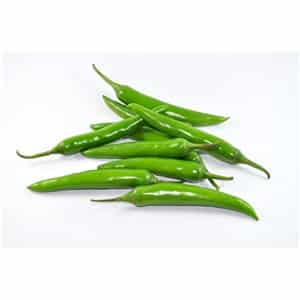
Green chili is a hot, elongated green chilli with a shiny surface.
The pepper breed with pea-shaped fruits grows like a liana-like shrub, clinging to nearby plants or artificial supports (fences). The fruits appear after the inflorescences and look like elongated branches of grapes with small green berries. The brush itself is thin and long, often reaching 15-18 cm. Each has 35-60 spherical drupes with a thin layer of pulp.
How is it different from red?
What are green chilies? This is the name of one of the stages of development of red chili pepper, its unripe form. Hybrid forms are also red varieties, but may have a different shape and, when overripe, turn dark brown.
Which is hotter - green or red?
Hotter red peppers because they are ripe. If you compare these peppers on the Scoville heat scale, then the red one has a value of 10-20 thousand, and the green one has a value of 2.5-8 thousand.
Varieties
Serrano is a Mexican variety named after the local Sierra mountain ranges. The fruits are small - no more than 4-5 cm, round in shape. The pulp is thin and dry, the surface is shiny. The taste is sour-burning, bright. Ripens in 3 months.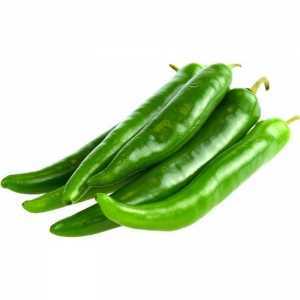
Jalapeño - a quickly ripening variety (the harvest can be harvested in 75 days), also bred in Mexico. These fruits are grown precisely in order to be harvested unripe, that is, green. They have a peculiar crescent shape, thick skin, weight about 45 g. The variety is distinguished not only by its medium pungency, but also by its spicy aftertaste with a sour tint. Often used in modern cuisine in different countries.
Anaheim - a Californian variety with a pungent taste and sweet smell. It is unpretentious in care and bears fruit on average 90 days after germination. The pods have a dark green color, an elongated cone-shaped shape and a small mass - about 15 g. Suitable for drying, pickling and fresh consumption.
Interesting! Pepper crops are divided into two varieties: Piper and Kapsikum. Representatives of Piper include peppercorns, and Capsicum is represented by pods, which are divided into chili and bell peppers.
Features of cultivation
Chili peppers are not so common in Russian gardens, so it is better to learn more about the rules for planting and caring for this plant.
Landing
You can plant chili from seedlings or from seeds. Grow You can make it at home all year round, but the best time is the beginning of March, then the harvest will be plentiful and the taste will be excellent. All species are grown in greenhouses, as they require identical maintenance conditions.
The optimal temperature to maintain is +20…+23°C. Pepper does not like drafts and direct ultraviolet light.It is better to place seedlings in peat with compost and turf with a drainage layer (sand, coal, expanded clay) 2 cm thick.
The seeds must be uniform in color, without spots, and of the same size. Before planting, they are disinfected by soaking for 15 minutes in a pink solution of potassium permanganate, then dried. They are germinated in damp gauze, and then planted in the ground to a depth of 5-6 cm, watered and covered with polyethylene until germination.
After the emergence of shoots with 2-3 shoots, they are transplanted into separate containers - dived - and then be sure to water them.
Transplanting seedlings into open ground or a greenhouse
Signs by which you can understand that it’s time to transplant peppers into open ground:
- sprout height - 11-15 cm;
- stands confidently in the ground, the roots are strengthened;
- the leaves are succulent, not sluggish, rich green color.
According to the recommendations of vegetable growers, a week before the planned transplant, boxes with seedlings are taken outside daily for 1-2 hours to adapt to the environment. In this case, it will be well accepted in open ground.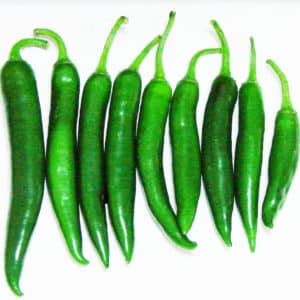
Chili peppers grow better in a greenhouse, since there are no drafts and the desired temperature and humidity can be maintained. When planting in open ground, preference is given to high beds.
The following types of soil are suitable for chili: chernozem, meadow-chernozem, sod-meadow. The required acidity is 5.5-7.0.
In autumn and spring, you can fertilize the soil with any manure (cow, pig, goat, etc.). A month before planting, the soil in the garden bed should be fertilized with superphosphate and humus, and a few days later it should be well loosened and saturated with oxygen.
It is not recommended to plant peppers in the place where tomatoes, tobacco, eggplants, potatoes and physalis grew last season.The harvest will be good if the bed is placed in the place where pumpkin, zucchini, squash, carrots or cucumbers were. Nearby you can place beds with herbs: dill, coltsfoot, basil, lettuce, spinach and others. After pepper, cereals and root crops will grow well in this place.
Care
Chili peppers need light, fertile soil with peat and compost, necessarily drained with sand, loose and moist. The plant must be illuminated for at least 15 hours a day, otherwise the fruits will be small or there will be none at all. But direct sunlight is undesirable.
Important! The optimal temperature for pepper is +22…+24°C. 2 weeks before planting, they are hardened by taking them outside for 2-8 hours a day.
Watered pepper every other day (every day in summer) with water at room temperature as the soil dries, pouring about 10 liters per 1 sq. m of soil.
They feed Green chilies are fertilized weekly with nitrogen fertilizers, and during flowering with potassium and fluoride-containing fertilizers. Chicken manure provides good nutrition for peppers, for which a small amount (500 g) is dissolved in 10 liters of water and the plants are watered twice a week.
Pepper can grow up to 1 m in height, but if you want to get a lower and branched bush, you need to pinch the top at the flowering stage or when it reaches the desired height. To ensure a better harvest and larger fruits, you need to cut off the additional stems that grow inward and remove at least a third of the flowers.
Loosening is very useful for peppers; it even replaces one watering. But it is carried out carefully due to the superficial location of the root system.
Diseases and pests
Chili peppers are rarely affected by any pathogens. To prevent them, you need to disinfect the seeds and soil before planting.
Pests that attack green chilies:
- nematodes;
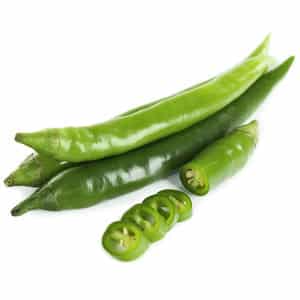
- aphids (potato, melon, peach);
- tick (transparent, field);
- bug (field, vegetable);
- thrips;
- nightshade miner;
- scoop.
Susceptible to bacterial, fungal and viral diseases:
- tobacco mosaic virus;
- bacterial, white and gray rot;
- pythium root rot (pythium);
- fusarium and verticillium wilt;
- rhizoctoniasis;
- Alternaria blight.
Physiological problems include:
- fruit cracks;
- dying off of shoot tips;
- pepper blossom end rot;
- sunburn;
- dropping peppers;
- deformation of fruits from excess nitrogen and due to temperature changes.
Treatment and prevention depend entirely on the type of lesion. If the causes are physiological, it is important to eliminate them as quickly as possible. In case of bacterial and pest damage, it is necessary to direct actions to eliminate the pathogen.
Reference. Damage to pepper is often secondary, that is, it spreads from other affected areas located in close proximity to the garden bed. If you carry out timely preventive maintenance of the entire garden, the risk of crop loss is minimal.
Application
Green chili peppers are used no less widely than red ones - in cooking, medicine, and cosmetology.
In cooking
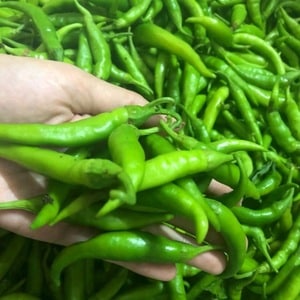
It is best to use it fresh. When cut and cooked, vitamin C is destroyed. Most often, green chilies are pickled - this preserves its beneficial properties.
Can also be used as a seasoning, included in various sauces, salads, add to pizza - a small amount gives the dish a sharp and spicy taste. Peppers are especially popular in Mexican folk cuisine. In Russia it is often used to decorate dishes before serving.
In folk medicine
Green chili pepper increases appetite, has a warming effect, dulls pain, therefore it is used for diseases of the musculoskeletal system. It is also known that the product helps prevent oncology of the respiratory system, prostate, and digestive organs. Vegetable juice kills germs and is recommended for diseases of the throat and mouth.
In cosmetology
In the beauty industry, pepper is used for various warming wraps and weight loss creams. It is also used to treat hair loss and baldness - due to the warming effect, blood flow to the hair follicles is stimulated, which strengthens them and promotes the growth of new hair.
Benefits and harms
Green chili pepper rich in vitamins and microelements. Doctors recommend it to patients with vitamin deficiency, reduced immunity, and chronic diseases of internal organs. There is also harm that a vegetable can cause to humans. Basically it comes down to injury to the digestive system.
Composition and properties
Green chilies contain high amounts of vitamin C—even more than citrus fruits. It is also rich in B vitamins, potassium, silicon, iodine and iron.
Calorie content - 37 kcal per 100 g. There is almost no fat in it, little protein, the main part is carbohydrates.
Impact on the body of women and men
How does pepper help men:
- Increases male strength (pepper tincture is useful).
- Increases testosterone production.
- Normalizes erection by stimulating blood flow to the penis.
- Reduces the harmful effects of alcohol on the body.
- When used externally, it prevents hair loss and baldness.
For women, pepper is useful for strengthening hair due to blood flow to the hair follicles, selenium and silicon content, as well as in the fight against cellulite and extra pounds. It has antioxidant properties and prevents aging. Vitamin C strengthens the walls of blood vessels and helps absorb iron and calcium.
Attention! For both sexes, the use of green pepper is contraindicated for diseases of the stomach, intestines, gallbladder and pancreas. It is undesirable for the fair sex to consume pepper during menstruation and is prohibited during pregnancy.
Standards of use
There are no standards for the use of this product, but it is reliably known that 50 g of pepper satisfies the daily requirement of an adult body for ascorbic acid.
Contraindications and possible harm
Green chili peppers are contraindicated and harmful for chronic gastritis, cholecystitis, stomach and duodenal ulcers, exacerbation of chronic pancreatitis. According to one theory for the development of stomach cancer, it occurs due to frequent consumption of chili spices. This conclusion was first reached based on the incidence of cancer of the digestive tract in the Japanese and Chinese, whose cuisine is oversaturated with hot spices.
It is also harmful in case of gastroesophageal reflux disease, after operations on the gastrointestinal tract, and hepatitis. In case of obesity, excessive consumption of chili causes an unnecessary increase in appetite.
Conclusion
Green chili peppers are rich in vitamins and microelements. The benefits of its use are greater than the harm, especially since it is contraindicated only for people with gastrointestinal diseases. Low in calories and pleasant in taste, it will add a spicy kick to any dish.To get a good harvest, you need to follow all the recommendations of agronomists, then it will be enough for both cosmetic procedures and salting.